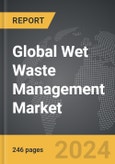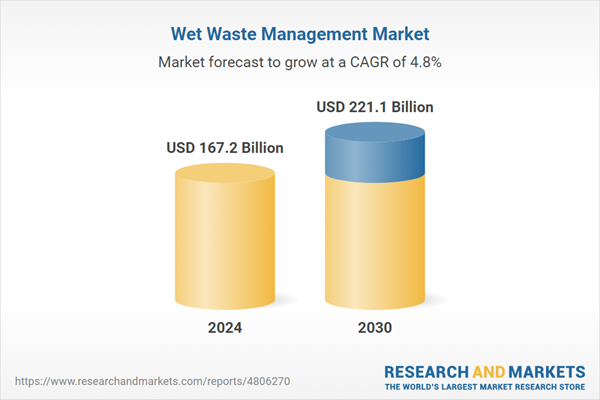The global market for Wet Waste Management was valued at USD 167.2 Billion in 2024 and is projected to reach USD 221.1 Billion by 2030, growing at a CAGR of 4.8% from 2024 to 2030. This comprehensive report provides an in-depth analysis of market trends, drivers, and forecasts, helping you make informed business decisions.
Global Wet Waste Management Market - Key Trends & Drivers Summarized
Why Is Wet Waste Management Becoming a Priority in Urban Areas?
Wet waste management is becoming an increasingly important issue in urban areas due to the rising volume of organic waste generated by households, restaurants, food processing units, and agricultural activities. Wet waste, which primarily consists of organic matter such as food scraps, vegetable peels, and garden waste, requires proper handling, collection, and treatment to prevent environmental pollution, greenhouse gas emissions, and public health hazards. The growing awareness of the environmental impact of improper waste disposal, coupled with stringent government regulations on waste management and sustainability, is driving the demand for efficient wet waste management solutions that include composting, anaerobic digestion, and waste-to-energy conversion.What Technological Innovations Are Shaping Wet Waste Management Practices?
Technological advancements are significantly enhancing the efficiency, sustainability, and scalability of wet waste management practices. Innovations such as automated waste segregation systems, smart bins equipped with sensors, and mobile applications for waste collection scheduling are improving waste handling and logistics, reducing human intervention and operational costs. The development of advanced composting technologies, such as in-vessel composting and aerobic digesters, is enabling faster and more efficient decomposition of organic waste, producing high-quality compost and reducing odor and leachate issues. Additionally, the use of anaerobic digestion technology for biogas production is gaining traction, providing a sustainable solution for wet waste disposal while generating renewable energy. The integration of Internet of Things (IoT) and data analytics is further optimizing waste management processes, providing real-time monitoring and insights for better decision-making.What Are the Challenges and Opportunities in the Wet Waste Management Market?
The wet waste management market faces several challenges, including the high costs of waste collection, transportation, and treatment infrastructure, the need for public awareness and participation, and the complexity of managing diverse waste streams. Additionally, the variability in waste composition and moisture content can affect the efficiency of waste treatment processes. However, these challenges also present opportunities for growth and innovation. The development of cost-effective and scalable wet waste treatment technologies that offer multiple benefits, such as energy production and nutrient recovery, can help address some of these challenges. The increasing emphasis on circular economy principles and sustainable urban development is creating new growth opportunities for integrated wet waste management solutions that minimize waste generation, promote recycling, and convert waste into valuable resources. Moreover, the rising trend of smart city initiatives is driving the need for digital and data-driven waste management solutions.What Is Driving the Growth of the Wet Waste Management Market?
The growth in the Wet Waste Management market is driven by several factors, including the increasing generation of organic waste in urban areas, stringent government regulations on waste disposal and recycling, and technological advancements in waste treatment and management systems. The growing focus on sustainability and environmental conservation is significantly boosting the demand for efficient wet waste management solutions that reduce landfill waste, lower greenhouse gas emissions, and produce renewable energy. Technological innovations such as automated waste segregation, advanced composting, and anaerobic digestion are enhancing the efficiency, scalability, and environmental impact of wet waste management, making them more attractive to municipalities, waste management companies, and agricultural sectors. The integration of IoT and data analytics in waste management, coupled with the expansion of smart city initiatives, is also driving market growth as cities seek to develop sustainable and data-driven waste management infrastructures.Report Scope
The report analyzes the Wet Waste Management market, presented in terms of market value (USD Thousand). The analysis covers the key segments and geographic regions outlined below.Segments
Service (Collection & Transportation, Processing, Disposal & Landfill, Sorting, Storage); Source (Municipal, Industrial, Healthcare & Medical, Commercial, Other Sources).Geographic Regions/Countries
World; United States; Canada; Japan; China; Europe (France; Germany; Italy; United Kingdom; and Rest of Europe); Asia-Pacific; Rest of World.Key Insights:
- Market Growth: Understand the significant growth trajectory of the Collection & Transportation Service segment, which is expected to reach $101.4 Billion by 2030 with a CAGR of a 4.9%. The Processing Service segment is also set to grow at 5.7% CAGR over the analysis period.
- Regional Analysis: Gain insights into the U.S. market, valued at $45.2 Billion in 2024, and China, forecasted to grow at an impressive 4.4% CAGR to reach $34.7 Billion by 2030. Discover growth trends in other key regions, including Japan, Canada, Germany, and the Asia-Pacific.
Report Features:
- Comprehensive Market Data: Independent analysis of annual sales and market forecasts in USD from 2024 to 2030.
- In-Depth Regional Analysis: Detailed insights into key markets, including the U.S., China, Japan, Canada, Europe, Asia-Pacific, Latin America, Middle East, and Africa.
- Company Profiles: Coverage of major players such as Ama Roma S.p.A., BDI Skip Bins, BlueRidge Environmetal, Inc., Clean Harbors, Inc., Compact and Bale Ltd. and more.
- Complimentary Updates: Receive free report updates for one year to keep you informed of the latest market developments.
Why You Should Buy This Report:
- Detailed Market Analysis: Access a thorough analysis of the Global Wet Waste Management Market, covering all major geographic regions and market segments.
- Competitive Insights: Get an overview of the competitive landscape, including the market presence of major players across different geographies.
- Future Trends and Drivers: Understand the key trends and drivers shaping the future of the Global Wet Waste Management Market.
- Actionable Insights: Benefit from actionable insights that can help you identify new revenue opportunities and make strategic business decisions.
Key Questions Answered:
- How is the Global Wet Waste Management Market expected to evolve by 2030?
- What are the main drivers and restraints affecting the market?
- Which market segments will grow the most over the forecast period?
- How will market shares for different regions and segments change by 2030?
- Who are the leading players in the market, and what are their prospects?
Some of the 46 major companies featured in this Wet Waste Management market report include:
- Ama Roma S.p.A.
- BDI Skip Bins
- BlueRidge Environmetal, Inc.
- Clean Harbors, Inc.
- Compact and Bale Ltd.
- Covanta Holding Corporation
- EcoCentral Limited
- Ecosupport Limited
- Ecube Labs, Inc.
- Evac Oy
Table of Contents
I. METHODOLOGYII. EXECUTIVE SUMMARY2. FOCUS ON SELECT PLAYERSIII. MARKET ANALYSISIV. COMPETITION
1. MARKET OVERVIEW
3. MARKET TRENDS & DRIVERS
4. GLOBAL MARKET PERSPECTIVE
UNITED STATES
CANADA
JAPAN
CHINA
EUROPE
FRANCE
GERMANY
ITALY
UNITED KINGDOM
REST OF EUROPE
ASIA-PACIFIC
REST OF WORLD
Companies Mentioned (Partial List)
A selection of companies mentioned in this report includes, but is not limited to:
- Ama Roma S.p.A.
- BDI Skip Bins
- BlueRidge Environmetal, Inc.
- Clean Harbors, Inc.
- Compact and Bale Ltd.
- Covanta Holding Corporation
- EcoCentral Limited
- Ecosupport Limited
- Ecube Labs, Inc.
- Evac Oy
Table Information
| Report Attribute | Details |
|---|---|
| No. of Pages | 246 |
| Published | April 2025 |
| Forecast Period | 2024 - 2030 |
| Estimated Market Value ( USD | $ 167.2 Billion |
| Forecasted Market Value ( USD | $ 221.1 Billion |
| Compound Annual Growth Rate | 4.8% |
| Regions Covered | Global |









